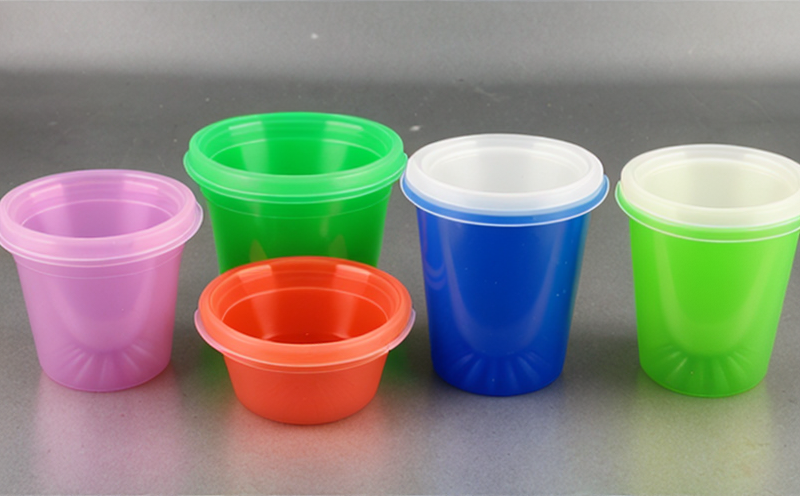ASTM F1249 Water Vapor Transmission Testing of Disposable Plastics
The ASTM F1249 standard provides a method to determine the water vapor transmission rate (WVTR) of barrier materials used in disposable plastics. This test is crucial for ensuring that packaging and other products maintain the integrity of their contents by controlling moisture permeation.
Water vapor transmission testing plays a vital role in several industries, including medical device manufacturing, food and beverage packaging, pharmaceuticals, and consumer goods. For instance, in the medical sector, accurate WVTR measurement helps prevent product contamination from excessive moisture ingress or loss during storage and transport.
The ASTM F1249 method involves placing a specimen between two chambers: one maintained at a high relative humidity (RH) level and the other at a lower RH. The vapor pressure difference drives water molecules through the material, which can then be measured over time to calculate WVTR. This process is conducted under controlled conditions, typically at 38°C for medical devices.
Specimen preparation involves selecting representative samples that accurately reflect the properties of the entire batch or lot. Samples should be cut into uniform strips with precise dimensions as specified in ASTM F1249 to ensure consistent testing results across different batches and suppliers.
The instrumentation used for WVTR testing includes a water vapor permeation apparatus, which can vary depending on the complexity required by the test. For basic applications, manual setups may suffice, while more advanced laboratories use automated equipment that continuously monitors moisture levels and calculates transmission rates over time.
Reporting of results should include detailed information about the specimen's dimensions, environmental conditions during testing, and calculated WVTR values along with uncertainties. Compliance with ASTM F1249 ensures that manufacturers meet regulatory requirements set by bodies like FDA or EU directives governing medical devices and packaging materials.
Understanding the importance of this test requires knowledge not only of its technical aspects but also its broader implications for industry standards and consumer safety. By adhering to these rigorous testing protocols, companies can ensure their products remain effective over extended periods without compromising quality or performance.
Why It Matters
The significance of ASTM F1249 water vapor transmission testing extends beyond mere compliance; it directly impacts product functionality and consumer trust. In industries where maintaining dryness is critical, such as pharmaceuticals or medical devices, even slight increases in WVTR can lead to spoilage or degradation of active ingredients.
- Product Integrity: Ensures that the intended moisture barrier properties are maintained throughout the product lifecycle.
- User Safety: Prevents potential hazards associated with compromised packaging integrity, like bacterial growth inside sealed containers.
For medical device manufacturers, accurate WVTR testing is essential for ensuring proper sterilization processes and preventing post-sterilization contamination. Incorrectly packaged devices could pose significant risks to patients if they do not maintain sterile conditions during storage or use.
The results from ASTM F1249 tests are often referenced in regulatory submissions and quality assurance documents, providing transparency about the product's performance characteristics. This transparency fosters trust between manufacturers, distributors, retailers, and ultimately consumers who rely on these products for their health and safety needs.
International Acceptance and Recognition
- The ASTM F1249 standard has been widely adopted by regulatory agencies around the world. It is recognized by the FDA (United States), MHRA (UK), EMA (EU), and other national authorities responsible for medical device regulation.
- Many international standards organizations, including ISO TC 58, have referenced ASTM F1249 as a key methodology in their own guidelines related to packaging materials.
This widespread acceptance underscores the importance of adhering to this standard when designing and manufacturing disposable plastics intended for global markets. Compliance enhances market access opportunities while reducing potential barriers due to non-conforming products.
Environmental and Sustainability Contributions
- The focus on minimizing water vapor permeation contributes positively towards reducing waste associated with discarded packaging materials. By improving the efficiency of moisture barriers, less material is needed overall, leading to lower resource consumption during production.
- Accurate WVTR testing supports efforts aimed at developing more sustainable packaging solutions that balance functionality with environmental impact. This aligns with broader trends towards circular economy principles and responsible resource management practices.
Through rigorous application of ASTM F1249, industries contribute to a more sustainable future by optimizing material usage and reducing unnecessary waste throughout the supply chain.





